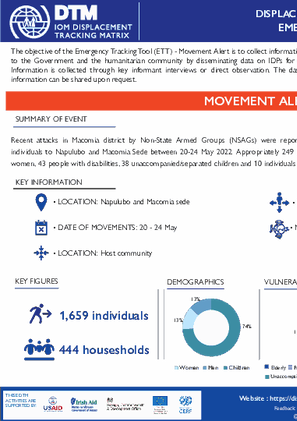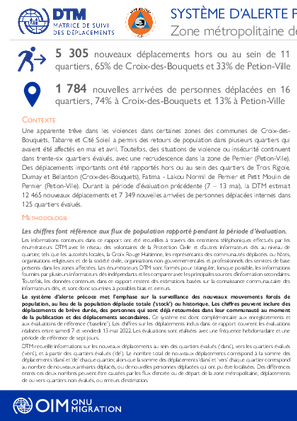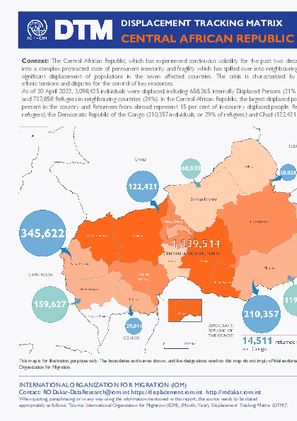-
Countries
-
Data and Analysis
-
Special Focus
-
Crisis Responses

Contact
DTMMozambique@iom.int
Language
English
Location
Mozambique
Period Covered
May 20 2022
May 24 2022
Activity
- Mobility Tracking
- Event Tracking
Recent attacks in Macomia district by Non-State Armed Groups (NSAGs) were reported between 20-23 May 2022, triggering the movements of 1,659 individuals to Napulubo and Macomia Sede between 20-24 May 2022. Appropriately 249 IDPs have been identified with vulnerabilities: 95 elderly, 63 pregnant women, 43 people with disabilities, 38 unaccompanied/separated children and 10 individuals with chronic diseases.

Contact
dtmdjiboutii@iom.int
Language
English
Location
Djibouti
Period Covered
Mar 29 2022
Mar 30 2022
Activity
- Survey
The objective of this report is to describe the experiences of Ethiopian migrants who are either migrating to the Arabian Peninsula or who have returned from Yemen and are currently in Obock, Djibouti. This report reflects the stories that migrants shared about their time in Yemen, the transit to Djibouti, their difficulties and intentions. It also presents the stories of the journey of those travelling from Ethiopia in the hope of reaching Saudi Arabia, their challenges, hopes, preparation and understanding of the journey ahead.
A total of seven focus group discussions (FGD) were organized by the International Organization for Migration (IOM) at the Migrant Response Centre (MRC) in Obock and at informal congregation points in Fantahero between the 29th and the 30st of March 2022. The FDGs involved a total of 40 people (24 men, 4 women and 12 boys).

Contact
dtmhaiti@iom.int
Language
French
Location
Haiti
Period Covered
May 14 2022
May 20 2022
Activity
- Mobility Tracking
- Event Tracking
Une apparente trêve dans les violences dans certaines zones des communes de Croix-des-Bouquets, Tabarre et Cité Soleil a permis des retours de population dans plusieurs quartiers qui avaient été affectés en mai et avril. Toutefois, des situations de violence ou insécurité continuent dans trente-six quartiers évalués, avec une recrudescence dans la zone de Pernier (Petion-Ville). Des déplacements importants ont été rapportés hors ou au sein des quartiers de Trois Rigole, Dumay et Bellanton (Croix-des-Bouquets), Fatima - Lakou Normil de Pernier et Petit Moulin de Pernier (Petion-Ville). Durant la période d’évaluation précédente (7 – 13 mai), la DTM estimait 12 465 nouveaux déplacements et 7 349 nouvelles arrivées de personnes déplacées internes dans 125 quartiers évalués.
La République centrafricaine (RCA) a été témoin de volatilité incessante depuis deux décennies. La dernière crise atteignant le pays a débuté en 2012, suite à une prise du pouvoir accouchée dans la violence, et a depuis évolué en un état d’insécurité et de fragilité permanentes, découlant d’une crise complexe de long-terme qui s’est étendue dans les pays voisins. La crise a conduit au décès d’au moins 5 000 personnes en 2021 (au 31 décembre) et a déclenché des déplacements massifs de populations dans les sept pays touches par la crise. Cette dernière est caractérisée par des rivalités pour le pouvoir parmi les élites du pays, l’absence d’institutions étatiques et d’investissement d’argent public, des tensions inter-ethniques et inter-religieuses et la lutte pour le contrôle de ressources..
Au 30 Avril 2022, 3 098 425 individus étaient déplacés, dont 658 265 Personnes déplacées internes (21% de la population déplacées), 1 339 514 Retournées (anciennes PDI) (43%), 362 788 Retournés de l’étranger (12%) et 737 858 Réfugiés dans les pays limitrophes (24%). En RCA, les Retournés anciennes PDI représentent la plus grande population affectée (57%), tandis que les PDI représentent 28 pour cent de la population atteinte dans le pays et les Retournés de l’étranger 15 pour cent de la population déplacée présente dans le pays. Les réfugiés centrafricains résident principalement au Cameroun (345 622 individus, soit 47% des réfugiés), la République démocratique du Congo (210 357 individus, soit 29% des réfugiés) et au Tchad (122 421 individus, soit 17% des réfugiés).
The Central African Republic, which has experienced continuous volatility for the past two decades, has been riddled by a crisis which ignited in 2012 with a violent takeover of power and has developed into a complex protracted state of permanent insecurity and fragility which has spilled over into neighbouring countries. The crisis has led to the death of an estimated 5,000 people in 2021 (as of 31 December) and triggered significant displacement of populations in the seven affected countries. The crisis is characterized by power struggles amongst elites, the absence of state institutions and public investment, religious and ethnic tensions and disputes for the control of key resources.
As of 30 April 2022, 3,098,425 individuals were displaced, including 658,265 Internally Displaced Persons (21% of the displaced population), 1,339,514 Returnees (former IDPs) (43%), 362,788 Returnees from abroad (12%) and 737,858 Refugees in neighbouring countries (24%). In the Central African Republic, the largest displaced population consists of Former IDP Returnees (57%), while IDPs represent 28 per cent of the displaced population present in the country and Returnees from abroad represent 15 per cent of in-country displaced people. Refugees from the Central African Republic are primarily hosted by Cameroon (345,622 individuals, or 47% of refugees), the Democratic Republic of the Congo (210,357 individuals, or 29% of refugees) and Chad (122,421 individuals, or 17% of refugees).
La crise dans le Bassin du lac Tchad est le résultat d’une combinaison complexe d’une multitude de facteurs, y compris un conflit armé impliquant des groups armés non étatiques, des niveaux extrêmes de pauvreté, un sous-développement persistent, et des bouleversements climatiques, qui ont conduit à des déplacements de populations importants. Au 30 avril 2022, le Cameroun, le Tchad, le Nigeria et le Niger accueillaient 5 503 092 individus affectés par la crise, dont des Personnes déplacées internes (PDI), des réfugiés et des retournés (anciennes PDI et retournés de l’étranger). 75 pour cent d’entre eux (soit 4 132 210 personnes) se trouvaient au Nigéria, 11 pour cent au Cameroun (634 189 personnes), 9 pour cent au Tchad (489 761 personnes) et 4 pour cent au Niger (246 932 personnes).
The crisis currently affecting the Lake Chad Basin states results from a complex combination of factors, including conflict with Non-State Armed Groups, extreme poverty, underdevelopment and a changing climate, which together have triggered significant displacement of populations. As of 25 May 2022, Cameroon, Chad, Niger and Nigeria were hosting an estimated 5,503,092 affected individuals made up of Internally Displaced Persons (IDPs), Refugees (both in- and out-of-camp), Returnees (Former IDPs and Returnees from abroad) and Third Country Nationals (TCNs). 75 per cent of the affected population (representing 4,132,210 individuals) were located in Nigeria, while 12 per cent resided in Cameroon (634,189 individuals), 9 per cent in Chad (489,761 individuals) and 4 per cent in Niger (246,932 individuals).
La région du Sahel central, et plus particulièrement la zone du Liptako Gourma, qui enjambe le Burkina Faso, le Mali et le Niger, est témoin d’une crise complexe qui comprend comme enjeux une compétition grandissante pour le contrôle de ressources; des bouleversements climatiques; une croissance démographique galopante; des niveaux élevés de pauvreté; l’absence d’opportunités économiques et un sentiment de désillusions quant au futur; des tensions communautaires; l’absence de présence étatique et le manque de services sociaux de base; et des violences provoquées par des réseaux de crime organisé et des groups armés non étatiques. La crise a engendré, en 2021, la mort de 5 000 personnes (au 31 décembre) et conduit à des déplacements de populations significatifs dans les quatre pays touches par la crise. Au 25 mai 2022, 2 562 457 individus étaient déplacés par la crise, y compris 2 361 130 Personnes déplacées internes (92% de la population affectée) et 201 328 réfugiés (8%). treize pour cent de la population déplacée (1 875 049 personnes) au Burkina Faso, 16 pour cent au Mali (400 517), 8 pour cent au Niger (202 366) et 3 pour cent en Mauritanie
(84 526).
The Central Sahel area, and in particular the Liptako Gourma region, which borders Burkina Faso, Mali and Niger, is affected by a complex crisis involving growing competition over dwindling resources; climatic variability; demographic pressure; high levels of poverty; disaffection and a lack of livelihood opportunities; communal tensions; the absence of state institutions and basic services; and violence related to organized crime and Non-State Armed Groups. The crisis has led to the death of an estimated 5,000 people in 2021 (as of 31 December) and triggered significant displacement of populations in the four affected countries. As of 25 May 2022, 2,562,457 individuals have been displaced, including 2,361,130 Internally Displaced Persons (92% of the displaced population) and 201,328 Refugees (8% of the displaced population). Seventy-three per cent of the displaced population (1,875,049 individuals) were located in Burkina Faso, while 16 per cent resided in Mali (400,517 individuals), 8 per cent in Niger (202,366 individuals) and 3 per cent in Mauritania (84,526 individuals).

Contact
DTM Uganda, dtmuganda@iom.int
Language
English
Location
Uganda
Period Covered
Apr 01 2022
May 24 2022
Activity
- Mobility Tracking
A total of 31,848 individuals were affected, representing 6,568 households. 1,236 individuals from 988 households were internally displaced by disasters. So far in 2022, 46,519 individuals have been affected by disasters, representing 11,368 households. A total of 4,434 individuals representing 1,521 households have been Internally displaced.





